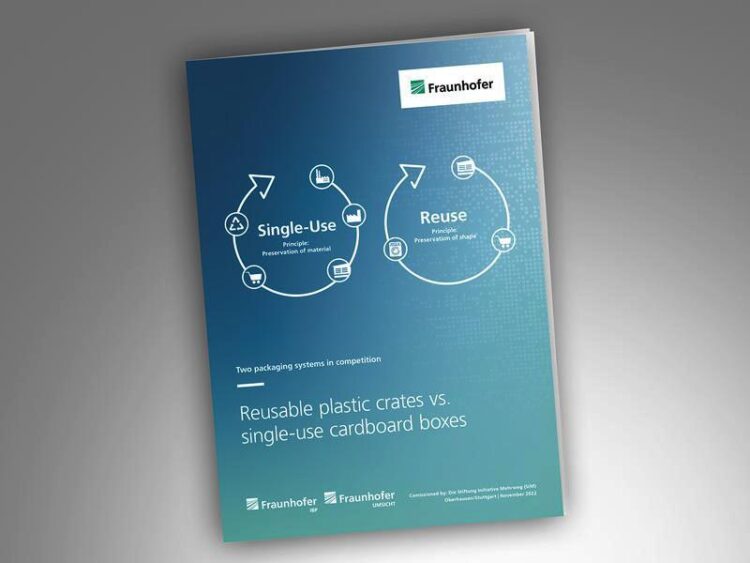Single-use cardboard boxes or reusable plastic crates

The researchers want to provide political and industrial desicion-makers with recommendations for action.
(c) Fraunhofer Institute for Environmental, Safety and Energy Technology UMSICHT
— which type of packaging is more sustainable?
The packaging world is experiencing a shift away from plastic toward paper, cardboard or paperboard. But how sustainable is this new trend? In its latest report “Reusable plastic crates vs. single-use cardboard boxes — two packag-ing systems in competition”1, the Fraunhofer Institute for Environmental, Safety and Energy Technology UMSICHT and the Fraunhofer Institute for Building Physics IBP were commissioned by the Stiftung Initiative Mehrweg (SIM) to explain the background to and correlations between the ecological effects of single-use cardboard boxes and reusable plastic crates.
Plastic or cardboard? Single-use or reusable? The question on which type of packaging is the more sustainable solution is not an easy one to answer. Among other things, comprehensive life cycle assessments (LCAs) are required that take into account the manufacturing process, transport, use and recycling at the end of the solution’s service life. The Fraunhofer institutes involved have already conducted several studies and life cycle assessments on plastic packaging, reusable systems and recycling solutions while also investigating the emissions of plastics into the environment2. The authors wish to provide political and industrial decision-makers with balanced recommendations for action to enable sustainable production and consumption, minimize the use of resources and significantly reduce plastic waste and emissions.
Comparative life cycle assessments require transparent parameters
The researchers’ present report concludes that, in most cases, reusable plastic packaging is superior in ecological terms to single-use cardboard packaging. The scientific teams refer to four studies in total, two commissioned by the European Federation of Corrugated Board Manufacturers (FEFCO) and conducted by VTT and Ramboll3, and two studies by Fraunhofer UMSICHT and Fraunhofer IBP commissioned by Stiftung Initiative Mehrweg (SIM)², and explain the general challenges and limits of comparative studies on environmental impacts. Often, the reasons for diverging results produced by comparative LCAs are due to different study parameters, the data used or even modeling approaches. “We therefore recommend that comparative life cycle assessments must be conducted on the basis of transparent, realistic parameters to be agreed upon in advance in a multi-stakeholder process. Furthermore, civil society — and not just competing associations — should also be involved in the process. It is up to the political players to enable this dialogue,” concludes lead author of the study Jürgen Bertling of Fraunhofer UMSICHT.
Promoting reusable systems, strengthening the waste hierarchy
The basic recommendation of the scientist teams for a decision between plastics or cardboard as a packaging material is: The waste hierarchy anchored in Europe (1. Avoidance, 2. Reuse – including repair or cleaning in particular – 3. Material Recycling and 4. Thermal Recycling and in the end 5. Disposal) must be maintained, strengthened and also implemented. Deviations from this hierarchy should only be possible if another solution is proven to be more advantageous when all relevant sustainability criteria are considered. This also comprises littering, product protection or technological sovereignty. This is because single-use packaging, for example, contributes significantly more to littering than reusable packaging. Reusable plastic packaging can protect products in a better way due to a higher material input which can be apportioned to several uses. In addition, they have a higher wet strength. Furthermore, reusable packaging systems reduce the import dependency as they promote regional logistics and transport solutions.
While a high recycling rate is, in principle, good for a circular economy, more of a focus needs to be placed on the reuse rate of secondary material for the same — or at least equivalent — purpose. This is the only way to avoid downcycling – recycled material is only suitable for products that do not have to apply to high quality requirements like e.g. for a palisade – and achieve a true circular economy. Moreover, the study’s authors recommend a transparent monitoring of the central parameters of reusable systems which include circulation figures, breakage and leakage rates, and end-of-life recycling rates in order to enable a fair comparison of the results.
1 Reusable plastic crates vs. single-use carboard boxes – two packaging systems in competition (Bertling et al. 2022)
2 Carbon Footprint von Verpackungssystemen für Obst- und Gemüsetransporte in Europa (Krieg et al. 2018);
Kunststoffbasierte Mehrwegsysteme in der Circular Economy (Bertling et al. 2022)
3 Recycling vs. Reuse for Packaging – Bringing the science to the packaging debate (FEFCO 2022);
A critical view on packaging recycling and reuse in the European Circular Economy (Pajula und Sundqvist-Andberg 2022);
Comparative Life Cycle Assessment (LCA) – Packaging Solutions for the Food Segment (Castellani et al. 2022)
Originalpublikation:
10.24406/publica-456 (Report in English)
10.24406/publica-424 (Report in German)
Weitere Informationen:
https://www.umsicht.fraunhofer.de/en/competencies/sustainability-participation.h… (Department Sustainability and Participatin)
https://www.umsicht.fraunhofer.de/en/research-for-the-market/ressources-manageme… (Resources Management in the Cicular Economy)
Media Contact
All latest news from the category: Ecology, The Environment and Conservation
This complex theme deals primarily with interactions between organisms and the environmental factors that impact them, but to a greater extent between individual inanimate environmental factors.
innovations-report offers informative reports and articles on topics such as climate protection, landscape conservation, ecological systems, wildlife and nature parks and ecosystem efficiency and balance.
Newest articles

First-of-its-kind study uses remote sensing to monitor plastic debris in rivers and lakes
Remote sensing creates a cost-effective solution to monitoring plastic pollution. A first-of-its-kind study from researchers at the University of Minnesota Twin Cities shows how remote sensing can help monitor and…

Laser-based artificial neuron mimics nerve cell functions at lightning speed
With a processing speed a billion times faster than nature, chip-based laser neuron could help advance AI tasks such as pattern recognition and sequence prediction. Researchers have developed a laser-based…

Optimising the processing of plastic waste
Just one look in the yellow bin reveals a colourful jumble of different types of plastic. However, the purer and more uniform plastic waste is, the easier it is to…



